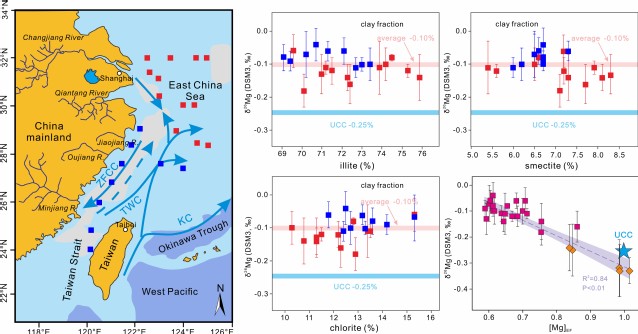Zhongya Hu, ,,,
State Key Laboratory of Marine Geology, School of Ocean and Earth Science, Tongji University, Shanghai, China
Abstract:In the last decade, much attention has been devoted to Mg isotopic behavior during various weathering processes. Nonetheless, whether Mg isotopes in terrigenous siliciclastic sediments in modern oceans can reflect continental weathering regimes remains unresolved. Understanding the major controls of Mg isotope fractionation in siliciclastic sediments is thus a prerequisite for decoding past Mg isotope records for tracing continental weathering history. In this study, we present mineralogical, elemental, and Mg isotopic compositions of terrigenous siliciclastic sediments in the Changjiang (Yangtze River) estuary and the adjacent continental shelf of the East China Sea. δ26Mg values of the clay-sized sediments vary from −0.15‰ to 0.00‰ and lack of the correlation with the proportion of different clay minerals. Our results suggest that the incipient to intermediate weathering processes are characterized by the progressive leaching of isotopically light Mg from silicates, leading to the enrichment of 26Mg in secondary clay minerals. Therefore, Mg isotopic variability of clay-sized sediments is primarily determined by catchment weathering, rather than by provenance lithology or mixing of clay minerals. An isotopic mass balance calculation indicates that the δ26Mg value of silicate weathering flux on a continental scale is ca. -0.60‰ to −0.40‰. The new constraint on the δ26Mg value of silicate weathering flux provides a new opportunity to better understand the Mg cycle. The Mg flux from silicate weathering in the Changjiang catchment is estimated as ∼15–17 × 1010 mol/yr, accounting for ca. 50% to 60% of the total Mg influx of Changjiang River into the ocean. In addition, numerical modeling with the up-to-date flux and isotope fractionation data have indicated that a slight enhancement of silicate weathering can potentially drive the rapid rise of Mg/Ca in seawater since late Cenozoic, but maintain the constancy of seawater δ26Mg as reported by literature. Our study demonstrates that Mg isotopes of clay-sized sediments can be used to constrain the relevant δ26Mg value of silicate weathering flux on a continental scale, which is a key parameter to trace the Mg cycle on Earth's surface.
Full Article:https://www.sciencedirect.com/science/article/pii/S0921818123002813


